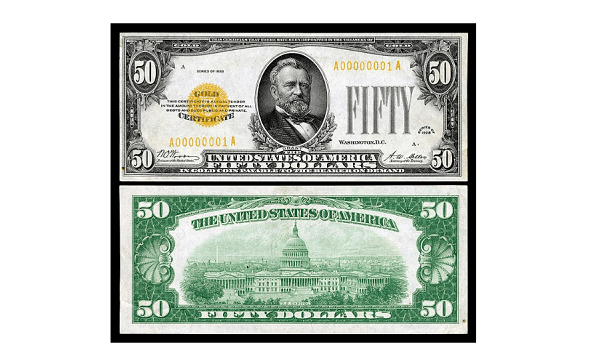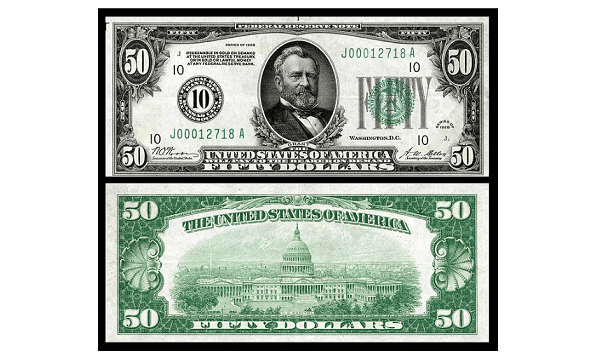1928 50 Dollar Bill Value – The 1928 50 dollar bill is a popular collector’s item for its unique design and historical significance. But beyond its aesthetic appeal, many are curious about the true value of this particular banknote.
In this blog post, we will take a closer look at the 1928 50 dollar bill value and delve into the factors that affect its worth in today’s market.
Stumbled upon one of these bills in an old collection or are considering purchasing one, read on to discover the fascinating world of the 1928 50 dollar bill.

The 1928 fifty dollar bills hold significant value in the collector’s market, and their worth can vary depending on the series and condition of the bill.
In particular, star notes, which are replacement bills printed by the United States Federal Reserve, are more rare and therefore more valuable. To identify if you have a star note, look for a star symbol at the end of the serial number.
1928 50 Dollar Bill Specifications
These banknotes have become popular collector’s items due to their unique design and historical significance. The 1928 50 dollar bill is a Federal Reserve Note with a denomination of $50.00 USD. It features a green seal and comes in two series: 1928 and 1928A.
When determining the value of a 1928 50 dollar bill, the series and condition of the bill play a crucial role.
Bills issued from the Federal Reserve Banks of Dallas and Minneapolis command higher prices.
Knowing the specifications of the 1928 50 dollar bill, such as its denomination, type, seal variety, and series, is crucial when assessing its value. Keep in mind that factors like rarity, demand, and market fluctuations can also impact the worth of these banknotes.
1928 50 Dollar Bill Value
The value of these banknotes depends on the series and condition of the bill. For most 1928 series $50 bills, you can expect them to be worth around $135-150 in very fine condition.
If the bill is in extremely fine condition, its value can go up to $250-300.
In uncirculated condition with an MS 63 grade, the price can reach around $800. However, if the bill was issued by the Federal Reserve Banks of Dallas and Minneapolis, it would be worth even more money.
For 1928A series $50 bills, the value ranges from $85-90 in very fine condition to around $125 in extremely fine condition.
In uncirculated condition with an MS 63 grade, the price can be around $350.

And remember, star notes, which are replacement bills printed by the United States Federal Reserve, are even more rare and valuable.
1928 50 Dollar Bill Star Notes
Do you have a 1928 50 dollar bill with a star symbol at the end of the serial number? If so, you may be holding a valuable piece of history.
So, how much is a 1928 $50 bill with a star note worth?
In very fine condition, most 1928 series $50 star notes are valued at around $425. If the note is in extremely fine condition, its value increases to around $825.
And if you happen to have an uncirculated star note with an MS 63 grade, the price can soar above $2,000. Keep in mind that star notes issued from the Federal Reserve Banks of Boston and Minneapolis can be worth even more money.
Valuable bills should be placed inside currency holders to prevent damage and maintain their condition.
So, check your collection or keep an eye out for these star notes.
1928 50 Dollar Bill Grading System
The grading system for these banknotes provides insight into their quality. A very fine 1928 $50 bill is one that has been in circulation but not for a long time. Despite some creases, folds, or light smudges, the note is still relatively crisp.
An extremely fine bill shows small signs of having been in circulation. It will be bright and have almost all of its original crispness, with only one or two minor creases or folds and no stains, discolorations, or tears.
The highest grade for a 1928 $50 bill is MS 63 choice uncirculated. This means the note shows no signs of ever having been in circulation and still retains its original crispness.
Additionally, the bill is well-centered. The better the grade of the bill, the higher its value in the collector’s market.
Understanding the grading system can help you determine the value of your 1928 $50 bill.
How to Maintain Your 1928 $50 Dollar Bill to Retain Its Value
To ensure that your 1928 $50 bill retains its value, there are a few steps you can take to maintain its condition.
First and foremost, it’s important to handle the bill with care and avoid touching it with bare hands, as oils and dirt can cause damage over time. Instead, use cotton gloves or hold the bill by its edges.
It’s also crucial to keep the bill away from direct sunlight, excessive heat, and moisture, as these elements can fade the ink and cause the paper to deteriorate.
Storing the bill in a temperature-controlled and humidity-controlled environment, such as a safe or a specialized currency holder, is highly recommended.
Regular cleaning is not necessary, as any attempts to clean or alter the bill may decrease its value. However, if you notice any dirt or debris on the bill, you can gently remove it with a soft brush or compressed air.
By following these maintenance tips, you can preserve the quality and value of your 1928 $50 bill for years to come.
So, make sure to take the necessary precautions to protect your valuable piece of currency history.
Conclusion
The value of a 1928 $50 bill can vary depending on the series and condition of the bill.
If you’re wondering how much is a 1928 $50 bill worth, it’s important to do your research and consider all the factors mentioned earlier. The series, condition, and whether it’s a star note all play a significant role in determining its value in the collector’s market.
With such a wide range of prices, it’s always exciting to see how much a 1928 $50 bill can be worth. So, whether you have one in your possession or come across one in the future, take the time to understand its value and appreciate the historical significance of this piece of currency.